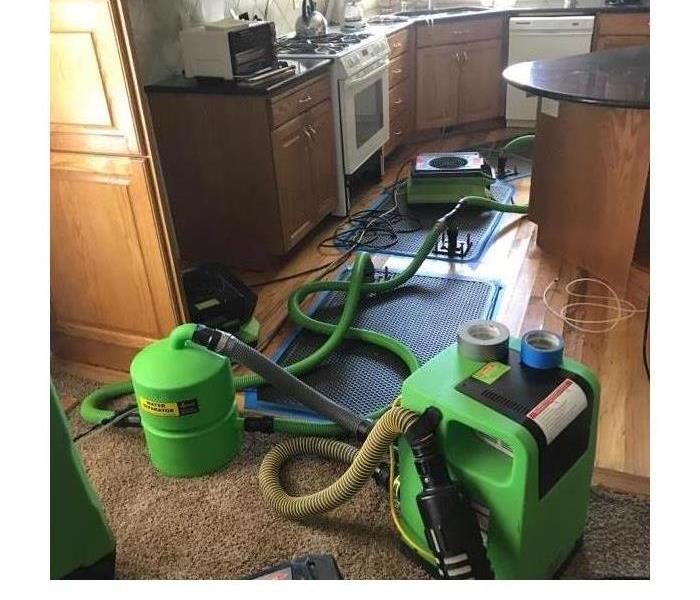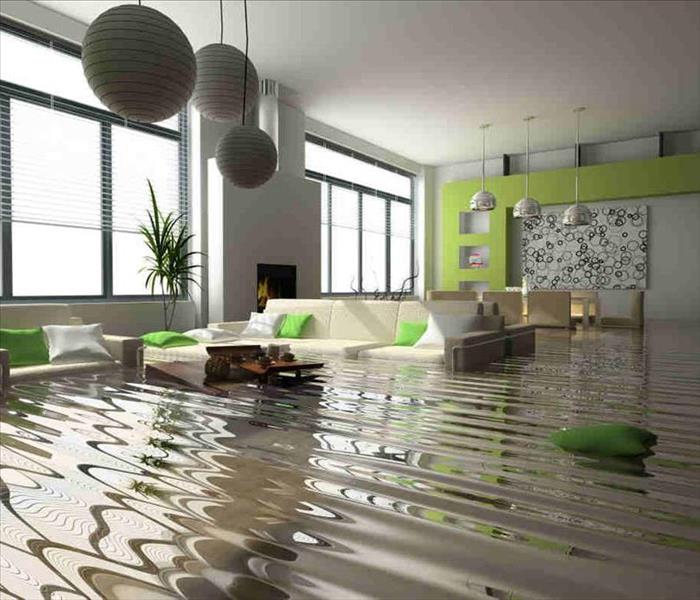Recent Water Damage Posts
Always the Season for Water clean-up
3/28/2025 (Permalink)
A SERVPRO water restoration technician has an extremely important job when a business or home is affected by excess water, sewage, moisture or fluid of some kind. Our certified professionals can quickly reverse the extensive damage that a flood, a pipe break or sewage backflow can cause, and try to save as many items as possible in the process. And when dealing with contaminated fluids, especially when it has pooled in the home, only trained and certified professional technicians should be allowed to manage the cleanup. Attempting to perform cleanup efforts without expert assistance can lead to injury or illness, both of which can be severe.
A SERVPRO certified water restoration technician is on call around the clock, except for those times when an entire community has been affected by a major disaster. As soon as a professional is on site, they will assess the situation and determine what items need immediate rescuing. If fluid has pooled in areas around the home, then pumps will be used to remove it.
The amount of damage water can cause is amazing, and often is underestimated by business owners and homeowners. Water always travels the path of least resistance. Excess moisture is bad enough, but when a business or home is flooded or hit with a plumbing disaster (like a burst pipe), the situation can quickly get out of hand. There’s a reason why these incidents are among the most expensive problems a homeowner can face. Contaminated water can create immediate structural problems.
Floods, sewage backflows, and other sources of contaminated fluid usually cause the worst damage. Dirty water is filled with all kinds of deadly substances, ranging from chemical residues to animal feces to parasites. Bacteria, viruses and fungi grow explosively in contaminated fluid.
This problem is compounded by the composition of most businesses and homes, which are filled with organic materials. Drywall, wood and the matter that is trapped in carpet fibers are just a few examples, and they can give pathogens room to grow. Within 48 hours, mold may begin creeping behind the walls and releasing spores. Any organic materials that have been soaked through by contaminated fluid will usually have to be destroyed.
We, SERVPRO, will dry the business or home quickly and apply antibacterial, antiviral, and antifungal agents to all surfaces that had contact with the water. This ensures the family can return to a safe home, and not one harboring a collection of deadly pathogens. You can Trust SERVPRO at 360-703-3884.
Its Water Clean up
3/12/2024 (Permalink)
A SERVPRO water restoration technician has an extremely important job when a business or home is affected by excess water, sewage, moisture or fluid of some kind. Our certified professionals can quickly reverse the extensive damage that a flood, a pipe break or sewage backflow can cause, and try to save as many items as possible in the process. And when dealing with contaminated fluids, especially when it has pooled in the home, only trained and certified professional technicians should be allowed to manage the cleanup. Attempting to perform cleanup efforts without expert assistance can lead to injury or illness, both of which can be severe.
A SERVPRO certified water restoration technician is on call around the clock, except for those times when an entire community has been affected by a major disaster. As soon as a professional is on site, they will assess the situation and determine what items need immediate rescuing. If fluid has pooled in areas around the home, then pumps will be used to remove it.
The amount of damage water can cause is amazing, and often is underestimated by business owners and homeowners. Water always travels the path of least resistance. Excess moisture is bad enough, but when a business or home is flooded or hit with a plumbing disaster (like a burst pipe), the situation can quickly get out of hand. There’s a reason why these incidents are among the most expensive problems a homeowner can face. Contaminated water can create immediate structural problems.
Floods, sewage backflows, and other sources of contaminated fluid usually cause the worst damage. Dirty water is filled with all kinds of deadly substances, ranging from chemical residues to animal feces to parasites. Bacteria, viruses and fungi grow explosively in contaminated fluid.
This problem is compounded by the composition of most businesses and homes, which are filled with organic materials. Drywall, wood and the matter that is trapped in carpet fibers are just a few examples, and they can give pathogens room to grow. Within 48 hours, mold may begin creeping behind the walls and releasing spores. Any organic materials that have been soaked through by contaminated fluid will usually have to be destroyed.
We, SERVPRO, will dry the business or home quickly and apply antibacterial, antiviral, and antifungal agents to all surfaces that had contact with the water. This ensures the family can return to a safe home, and not one harboring a collection of deadly pathogens. You can Trust SERVPRO at 360-703-3884.
Water can and will Damage
3/6/2023 (Permalink)
A SERVPRO water restoration technician has an extremely important job when a business or home is affected by excess water, sewage, moisture or fluid of some kind. Our certified professionals can quickly reverse the extensive damage that a flood, a pipe break or sewage backflow can cause, and try to save as many items as possible in the process. And when dealing with contaminated fluids, especially when it has pooled in the home, only trained and certified professional technicians should be allowed to manage the cleanup. Attempting to perform cleanup efforts without expert assistance can lead to injury or illness, both of which can be severe.
A SERVPRO certified water restoration technician is on call around the clock, except for those times when an entire community has been affected by a major disaster. As soon as a professional is on site, they will assess the situation and determine what items need immediate rescuing. If fluid has pooled in areas around the home, then pumps will be used to remove it.
The amount of damage water can cause is amazing, and often is underestimated by business owners and homeowners. Water always travels the path of least resistance. Excess moisture is bad enough, but when a business or home is flooded or hit with a plumbing disaster (like a burst pipe), the situation can quickly get out of hand. There’s a reason why these incidents are among the most expensive problems a homeowner can face. Contaminated water can create immediate structural problems.
Floods, sewage backflows, and other sources of contaminated fluid usually cause the worst damage. Dirty water is filled with all kinds of deadly substances, ranging from chemical residues to animal feces to parasites. Bacteria, viruses and fungi grow explosively in contaminated fluid.
This problem is compounded by the composition of most businesses and homes, which are filled with organic materials. Drywall, wood and the matter that is trapped in carpet fibers are just a few examples, and they can give pathogens room to grow. Within 48 hours, mold may begin creeping behind the walls and releasing spores. Any organic materials that have been soaked through by contaminated fluid will usually have to be destroyed.
We, SERVPRO, will dry the business or home quickly and apply antibacterial, antiviral, and antifungal agents to all surfaces that had contact with the water. This ensures the family can return to a safe home, and not one harboring a collection of deadly pathogens. You can Trust SERVPRO at 360-703-3884.
We Serve and are the Pro's
2/14/2022 (Permalink)
Why You Should Call a Professional like SERVPRO
- Each category of water is different
There are three categories of water: clean, gray, and black. Water falls into each category based on its source. Each source has different implications including safety precautions and cleanup needs. This means that just because a small flood at home may have water that is “clean”, the water can be potentially harmful, needing more than just a mop and some rags to clean.
- More than the floors may be wet
If there is slight flooding in your kitchen, bathroom, or laundry room, these areas most likely are surrounded by tile; they are also surrounded by building materials like cupboards or drywall. Drywall, unbeknownst to you, may become saturated with water and extremely heavy. The more water the drywall holds the more unstable it becomes, causing structural damage that you may not be aware of.
Electrical wires or appliances may have also taken on water, causing a high risk to homeowners as this may pose damage later on for these items.
- You don't have the proper equipment
If a flood appears to be small and contained, there may not be a question as to the length of time the water has been apparent. Without properly vetting all surrounding areas and building materials, it is impossible to tell if a “small” flood was truly small and non-damaging. Homeowners lack the ability to make these assessments. Homeowners also lack the proper equipment to dry out areas that have experienced water damage. Even the smallest amount of moisture left, given the right environment, can pose the threat of mold damage.
When it comes to floods and accompanying water damage, leave the cleanup to the pros. Regardless of the size or area affected, water has the ability to permeate through many materials, locking moisture in where it should not exist. Call a local professional restoration company like SERVPRO of Longview/Kelso to handle all of your water. We are here to Serve you and we are Professionals. We are locally owned and operated. We are SERVPRO of Longview/Kelso and we can be reached at 360-703-3884.
Not just water
2/7/2022 (Permalink)
A SERVPRO water restoration technician has an extremely important job when a business or home is affected by excess water, sewage, moisture or fluid of some kind. Our certified professionals can quickly reverse the extensive damage that a flood, a pipe break or sewage backflow can cause, and try to save as many items as possible in the process. And when dealing with contaminated fluids, especially when it has pooled in the home, only trained and certified professional technicians should be allowed to manage the cleanup. Attempting to perform cleanup efforts without expert assistance can lead to injury or illness, both of which can be severe.
A SERVPRO certified water restoration technician is on call around the clock, except for those times when an entire community has been affected by a major disaster. As soon as a professional is on site, they will assess the situation and determine what items need immediate rescuing. If fluid has pooled in areas around the home, then pumps will be used to remove it.
The amount of damage water can cause is amazing, and often is underestimated by business owners and homeowners. Water always travels the path of least resistance. Excess moisture is bad enough, but when a business or home is flooded or hit with a plumbing disaster (like a burst pipe), the situation can quickly get out of hand. There’s a reason why these incidents are among the most expensive problems a homeowner can face. Contaminated water can create immediate structural problems.
Floods, sewage backflows, and other sources of contaminated fluid usually cause the worst damage. Dirty water is filled with all kinds of deadly substances, ranging from chemical residues to animal feces to parasites. Bacteria, viruses and fungi grow explosively in contaminated fluid.
This problem is compounded by the composition of most businesses and homes, which are filled with organic materials. Drywall, wood and the matter that is trapped in carpet fibers are just a few examples, and they can give pathogens room to grow. Within 48 hours, mold may begin creeping behind the walls and releasing spores. Any organic materials that have been soaked through by contaminated fluid will usually have to be destroyed.
We, SERVPRO, will dry the business or home quickly and apply antibacterial, antiviral, and antifungal agents to all surfaces that had contact with the water. This ensures the family can return to a safe home, and not one harboring a collection of deadly pathogens. You can Trust SERVPRO at 360-703-3884.
You are in Control
1/17/2022 (Permalink)
As you are aware, accidents of any kind can happen at any moment and water damage in your home or business can strike when you least expect it. When it does, do not let the situation control you. You make sure you control it. One way to do just that is to call in the pros. SERVPRO to be exact. SERVPRO has been working directly with many insurance companies for the past 45 years. Your insurance company is probably one. Now as a homeowner, when something happens in our home, our first response is to do something to start the process to make it better. So when an accident happens that results in water damage, here are some helpful tips to perform, after you call us and before we arrive.
- Shut off the water source if possible.
- Remove excess water by mopping.
- Place aluminum foil or wood blocks under furniture legs.
- Do not use regular vacuum to remove water.
- Do not turn on ceiling fixtures if ceiling is wet, and keep away of areas where ceiling are sagging from retained water.
- Do not leave books, magazines or other colored items on wet carpeting.
- Hang furs and leather goods separately at room temperature.
- Remove oriental or other colored rugs from wet carpeting.
Performing these tasks could help further damage to your home.
Your locally owned SERVPRO can be reached at (360) 703-3884
Knowledge is Power
12/1/2021 (Permalink)
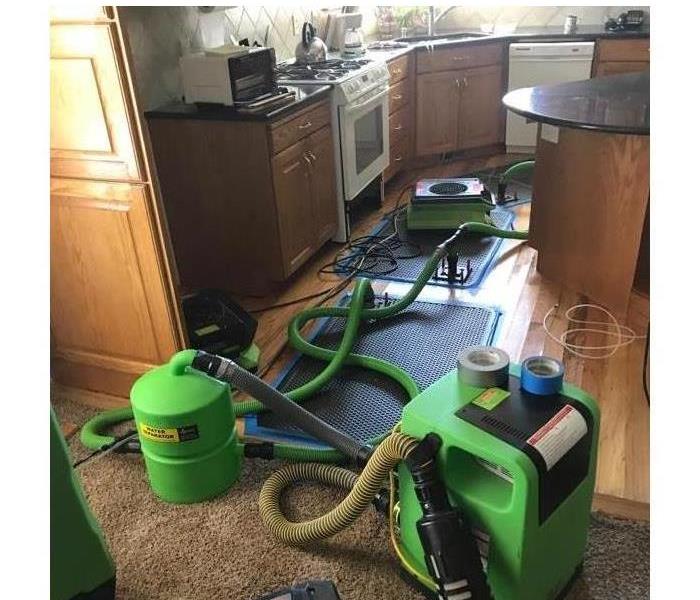 Drying with drying mats
Drying with drying mats
When SERVPRO is hired to mitigate a water damage job, the customer is counting on us to be the expert. We need to be knowledgeable about all the latest drying techniques, content management, occupant safety, air quality, etc. And one way to show that we know what we are doing and talking about is by staying on top of all aspects of the project. Here are just a few of the questions that we ask ourselves on every water job:
- What other contractors need to be involved in this project? Plumbers, flooring, drywall, etc. If even needed.
- How many items have been permanently damaged?
Can I explain and justify each piece of equipment we’re using on the job?
When should the amount of air movement be scaled back or removed?
Are the techs using moisture meters properly to get the most accurate measurements and have I made sure they’re using the same meter throughout the life of the job?
These are just a few questions that someone without disaster restoration training wouldn’t even think to ask. But since the industry constantly evolves and improves, we at SERVPRO do not try to get by with only what we first learned when you got into this business, in 1967. We regularly perform in-house training, watch the latest SERVPRO corporate video training seminars and attend workshops and trade shows when available. Knowledge, after all, is power. When we at SERVPRO are confident, you the customer and client, can be confident that the job will be completed correctly.
Key water loss questions
11/15/2021 (Permalink)
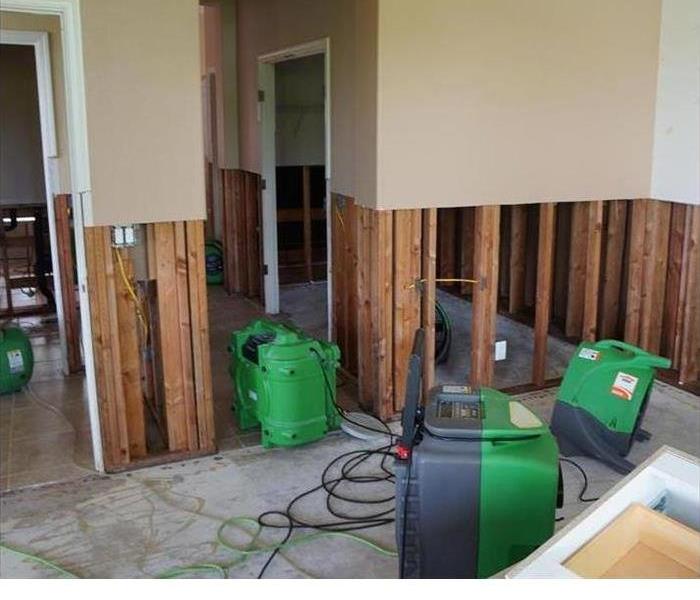 Sheetrock cut out
Sheetrock cut out
When SERVPRO of Longview/Kelso receives the call for a water loss or emergency, We will ask you a few key questions like, "Where is the water coming from" and "How much of the area has it affected". Here at SERVPRO from the initial phone call, to when our technicians arrive. We are assessing the damage and categorizing the type of water and classifications. Assessing the severity of the damage is important to determine what is needed to start the restoration and water removal process. A few of the various reasons we categorize is: 1- To know the level of care our technicians must take to safely work. 2- Preparing what equipment or tools are needed to quickly respond to the job. And 3- To best advise you of other safety measures you may need to take and helpful advise to minimize damage if possible.
The 3 Categories and what they mean:
- Category 1water/clean water: A clean source like a broken water line, appliances, sink overflow ext. The water in category 1 in other words is considered sanitary and is not yet a substantial risk.
- Category 2 water/ gray water: Water is significantly contaminated and can be harmful if consumed. Sources that may cause this type of water damage include toilets, sump pumps, and sewage.
- Category 3 water/ black water: Unsanitary water that contains bacteria, untreated sewage, harsh chemicals and microbes. Flooding rivers and sewage backups are a couple sources that may cause this water damage but standing water and storm surges also are highly contaminated too.
We also use different classifications to help determine the extent of the water damage that you may have experienced. This is why we ask "How much has it affected". It's important because it helps us know what drying techniques to use, the amount of equipment to set-up and how long the drying process may take.
4 Water classifications:
- Class 1:The least harmful because affected materials absorb only small amounts of the water and involves less absorption and evaporation. Commonly only a small portion of a room is affected.
- Class 2: A larger amount of water that has a fast rate of evaporation. Which means carpets and pads are affected, however water has not wicked up the walls more then 24 inches. Water damage repairs are more difficult.
- Class 3: The water in this class has the fastest rate of evaporation and the greatest amount of water. It is commonly from overhead sources or sprinkler system. It can affect ceilings, walls, insulation, carpet/pad and subflooring. Class 3 is when the entire area is affected.
- Class 4: We often use this class for specialty drying situations. It affects materials with low permeance and porosity and can have longer drying times and methods. Types of damage can affect hardwood flooring, plaster and concrete.
We are prepared to help, no matter the category or class of your water emergency. We have seen it all!
SERVPRO of Longview/kelso is always ready when you need us. Trusted, local and ready to restore.
Your water damage needs are not going to wait, so why should you. Give us a call at (360)703-3884 and let our trained and certified water technicians do the rest
Frozen
11/15/2021 (Permalink)
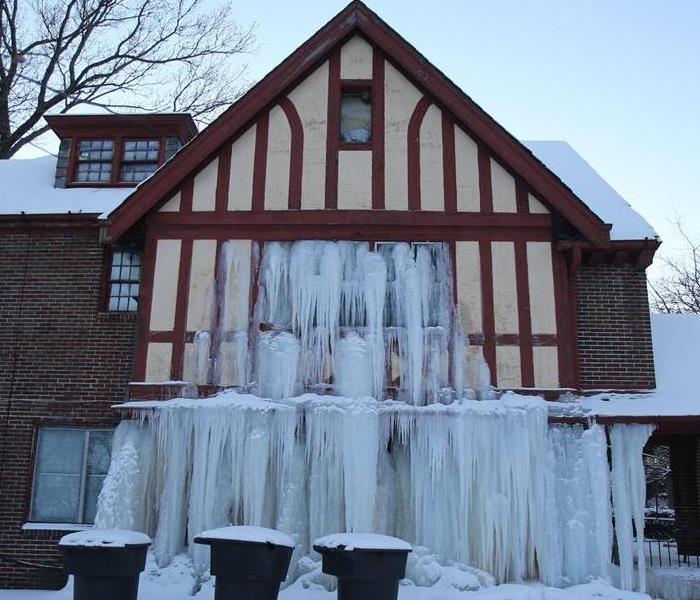 Frozen House
Frozen House
Some parts of the country are coming into the time of year where the thermometer drops, snow starts falling from the sky and yes ice forms on many things. In the winter months we come across water damages that are due to pipes that freeze, then when they thaw, they pop and burst. Sure these accidents are caused by the season, but one can say that they are also caused by neglect. Pipes in the crawl space, basement, attic (if your house is on a concrete slab) are at risk of bursting if they are not properly insulated, thus resulting in extensive Water Damage and costly repairs.
As the water in your pipes slowly freezes, the pressure will begin to increase. If the pressure is allowed to build, then the pipes will not be able to contain the frozen water within and can cause the pipes to break, crack and burst. Here are a few tips to help protect your pipes: Obviously insulate your pipes. Allow faucets to slowly drip, to minimize pressure build up and keep water moving. Open cabinet doors, to allow warmer air to circulate around plumbing. Maintain pipes and routinely inspect to avoid unknown water leaks. Always keep the thermostat on even when you are not home.
It's important to winterize your home before winter sets in. Foam pipe insulation is an inexpensive way to protect and prevent freezing.
The locally owned SERVPRO in your area understands that not all disasters can be avoided. A leaky or burst pipe can occur anywhere and at anytime. Our highly trained water restoration technicians are fully prepared to respond to emergency services 24-Hours, Including holidays.
Immediate action is considerably important in limiting any water damage. We have the expertise and equipment to professionally restore your property. Give us a call SERVPRO of Longview/Kelso (360)703-3884. We'll conduct a advanced water-inspection, complete extraction, and use our high-end drying equipment and techniques to restore your home. We are “ready for whatever happens.”
Hire a Professional
2/12/2021 (Permalink)
Why You Should Call a Professional like SERVPRO
- Each category of water is different
There are three categories of water: clean, gray, and black. Water falls into each category based on its source. Each source has different implications including safety precautions and cleanup needs. This means that just because a small flood at home may have water that is “clean”, the water can be potentially harmful, needing more than just a mop and some rags to clean.
- More than the floors may be wet
If there is slight flooding in your kitchen, bathroom, or laundry room, these areas most likely are surrounded by tile; they are also surrounded by building materials like cupboards or drywall. Drywall, unbeknownst to you, may become saturated with water and extremely heavy. The more water the drywall holds the more unstable it becomes, causing structural damage that you may not be aware of.
Electrical wires or appliances may have also taken on water, causing a high risk to homeowners as this may pose damage later on for these items.
- You don't have the proper equipment
If a flood appears to be small and contained, there may not be a question as to the length of time the water has been apparent. Without properly vetting all surrounding areas and building materials, it is impossible to tell if a “small” flood was truly small and non-damaging. Homeowners lack the ability to make these assessments. Homeowners also lack the proper equipment to dry out areas that have experienced water damage. Even the smallest amount of moisture left, given the right environment, can pose the threat of mold damage.
When it comes to floods and accompanying water damage, leave the cleanup to the pros. Regardless of the size or area affected, water has the ability to permeate through many materials, locking moisture in where it should not exist. Call a local professional restoration company like SERVPRO of Longview/Kelso to handle all of your water. 360-703-3884
Nasty unsafe Water
2/2/2021 (Permalink)
A SERVPRO water restoration technician has an extremely important job when a business or home is affected by excess water, moisture or fluid. Our certified professionals can quickly reverse the extensive damage that a flood, a pipe break or sewage backflow can cause, and try to save as many items as possible in the process. And when dealing with contaminated fluids, especially when it has pooled in the home, only trained and certified professional technicians should be allowed to manage the cleanup. Attempting to perform cleanup efforts without expert assistance can lead to injury or illness, both of which can be severe.
A SERVPRO certified water restoration technician is on call around the clock, except for those times when an entire community has been affected by a major disaster. As soon as a professional is on site, they will assess the situation and determine what items need immediate rescuing. If fluid has pooled in areas around the home, then pumps will be used to remove it.
The amount of damage water can cause is amazing, and often is underestimated by business owners and homeowners. Water always travels the path of least resistance. Excess moisture is bad enough, but when a business or home is flooded or hit with a plumbing disaster (like a burst pipe), the situation can quickly get out of hand. There’s a reason why these incidents are among the most expensive problems a homeowner can face. Contaminated water not only creates immediate structural problems, it can leave serious health and biological threats behind after it has been removed.
Floods, sewage backflows, and other sources of contaminated fluid usually cause the worst damage. Dirty water is filled with all kinds of deadly substances, ranging from chemical residues to animal feces to parasites. Bacteria, viruses and fungi grow explosively in contaminated fluid, and severe health risks, like salmonella and hepatitis, are common in flood waters.
This problem is compounded by the composition of most businesses and homes, which are filled with organic materials. Drywall, wood and the matter that is trapped in carpet fibers are just a few examples, and they can give pathogens room to grow. Within 48 hours, mold may begin creeping behind the walls and releasing spores. Any organic materials that have been soaked through by contaminated fluid will usually have to be destroyed.
We, SERVPRO, will dry the business or home quickly and apply antibacterial, antiviral, and antifungal agents to all surfaces that had contact with the water. This ensures the family can return to a safe home, and not one harboring a collection of deadly pathogens. You can Trust SERVPRO.
Control the Water Damage
1/12/2021 (Permalink)
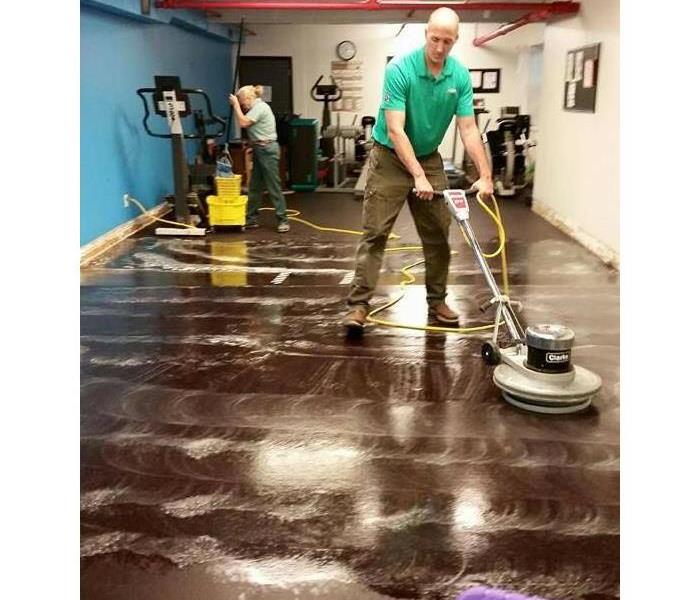 The Owner Cleaning up some Water Damage
The Owner Cleaning up some Water Damage
As you are aware, accidents of any kind can happen at any moment and water damage in your home or business can strike when you least expect it. When it does, do not let the situation control you. You make sure you control it. One way to do just that is to call in the pros. SERVPRO to be exact. SERVPRO has been working directly with many insurance companies for the past 45 years. Your insurance company is probably one. Now as a homeowner, when something happens in our home, our first response is to do something to start the process to make it better. So when an accident happens that results in water damage, here are some helpful tips to perform, after you call us and before we arrive.
- Shut off the water source if possible.
- Remove excess water by mopping.
- Place aluminum foil or wood blocks under furniture legs.
- Do not use regular vacuum to remove water.
- Do not turn on ceiling fixtures if ceiling is wet, and keep away of areas where ceiling are sagging from retained water.
- Do not leave books, magazines or other colored items on wet carpeting.
- Hang furs and leather goods separately at room temperature.
- Remove oriental or other colored rugs from wet carpeting.
Performing these tasks could help further damage to your home.
Your locally owned SERVPRO can be reached at (360) 703-3884
Drying Methods Change Daily
12/1/2020 (Permalink)
Contractors that work on construction projects closely follow blueprints which tell them exactly how a job is to be completed. But with water mitigation, things aren’t as cut and dried. The way one restoration contractor completes a job may be decidedly different from the way you may handle one due to current local weather conditions, although both have similar damage. For instance, while some parts of the country may be deluged with water, drought conditions persist in other areas. So, the manner of restorative dehumidification and drying that are applied in these regions may differ.
SERVPROs goal is to dry a structure as quickly as possible. To do so, we’ll need to dehumidify at a pace that’s equal to or greater than the amount of evaporation. In order to accomplish that, dehumidifiers, air movers and/or an exchange of drier air to replace the humid atmosphere will be needed. That leaves three drying choices:
- Open Drying: If the outside air is dryer than inside, using this method gets dry air circulating by opening windows and doors that will allow fresh, dryer air inside to assist in drying. We’ll employ air movers to circulate the drier air. This also speeds up the drying process. If the humidity is low enough, dehumidifiers may not even be necessary.
- Closed Drying: If the outside air has a higher specific humidity, then we’ll probably want to use this system where the windows and doors are closed and we will use dehumidifiers, air movers and dry heat to accelerate evaporation.
- Combination Drying: With low outside humidity, we will double up our efforts by using both open and closed drying systems together. This system makes use of both natural and mechanical elements that accelerate the drying process, opening and closing the windows and doors as needed.
If there’s low outside humidity but the temperature is below 70° F, then either use a closed system or add heat that'll encourage evaporation. But whatever the case, there are many factors that can affect what we ultimately decide to do, such as major changes in the weather, security issues, customer preferences, etc.
These are just a few techniques our trained and certified technicians learn. Independent franchise owners have a common responsibility to make sure their techs are certified and trained the SERVPRO way.
Your Water Pipes
11/18/2020 (Permalink)
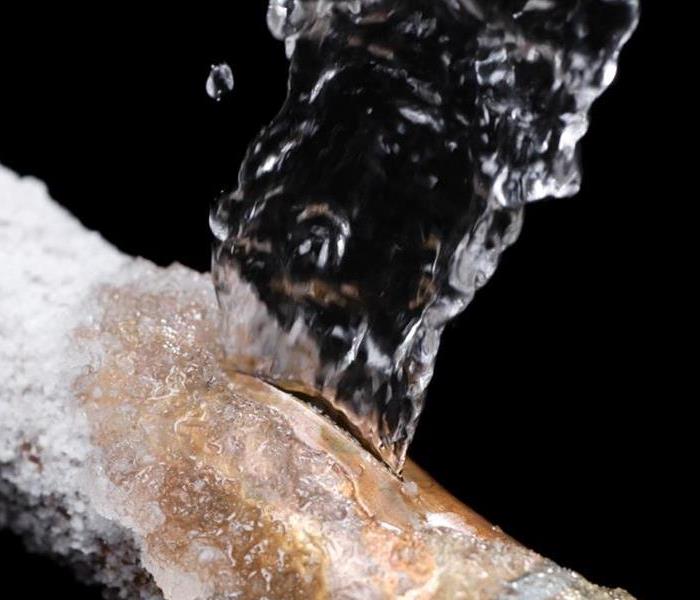 water pipe bursting
water pipe bursting
We are coming into the time of year where the thermometer drops and snow starts falling from the sky. In the winter months we come across water damages that are due to pipes that freeze, then when they thaw, they pop and burst. Sure these accidents are caused by the season, but one can say that they are also caused by neglecte. Pipes in the crawl space, basement, attic (if your house is on a concrete slab) are at risk of bursting if they are not properly insulated, thus resulting in extensive Water Damage and costly repairs.
As the water in your pipes slowly freezes, the pressure will begin to increase. If the pressure is allowed to build, then the pipes will not be able to contain the frozen water within and can cause the pipes to break, crack and burst. Here are a few tips to help protect your pipes: Obviously insulate your pipes. Allow faucets to slowly drip, to minimize pressure build up and keep water moving. Open cabinet doors, to allow warmer air to circulate around plumbing. Maintain pipes and routinely inspect to avoid unknown water leaks. Always keep the thermostat on even when you are not home.
It's important to winterize your home before winter sets in. Foam pipe insulation is an inexpensive way to protect and prevent freezing.
The locally owned SERVPRO in your area understands that not all disasters can be avoided. A leaky or burst pipe can occur anywhere and at anytime. Our highly trained water restoration technicians are fully prepared to respond to emergency services 24-Hours, Including holidays.
Immediate action is considerably important in limiting any water damage. We have the expertise and equipment to professionally restore your property. Give us a call SERVPRO of Longview/Kelso (360)703-3884. We'll conduct a advanced water-inspection, complete extraction, and use our high-end drying equipment and techniques to restore your home. We are “ready for whatever happens.”
Categories of Water
11/9/2020 (Permalink)
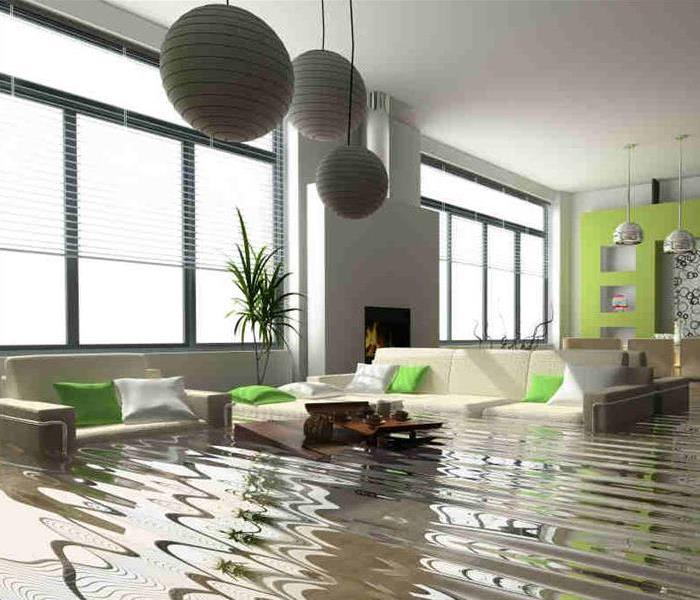 Flooded Living Room
Flooded Living Room
When SERVPRO of Longview/Kelso receives the call for a water loss or emergency, We will ask you a few key questions like, "Where is the water coming from" and "How much of the area has it affected". Here at SERVPRO from the initial phone call, to when our technicians arrive. We are assessing the damage and categorizing the type of water and classifications. Assessing the severity of the damage is important to determine what is needed to start the restoration and water removal process. A few of the various reasons we categorize is: 1- To know the level of care our technicians must take to safely work. 2- Preparing what equipment or tools are needed to quickly respond to the job. And 3- To best advise you of other safety measures you may need to take and helpful advise to minimize damage if possible.
The 3 Categories and what they mean:
- Category 1water/clean water: A clean source like a broken water line, appliances, sink overflow ext. The water in category 1 in other words is considered sanitary and is not yet a substantial risk.
- Category 2 water/ gray water: Water is significantly contaminated and can be harmful if consumed. Sources that may cause this type of water damage include toilets, sump pumps, and sewage.
- Category 3 water/ black water: Unsanitary water that contains bacteria, untreated sewage, harsh chemicals and microbes. Flooding rivers and sewage backups are a couple sources that may cause this water damage but standing water and storm surges also are highly contaminated too.
We also use different classifications to help determine the extent of the water damage that you may have experienced. This is why we ask "How much has it affected". It's important because it helps us know what drying techniques to use, the amount of equipment to set-up and how long the drying process may take.
4 Water classifications:
- Class 1:The least harmful because affected materials absorb only small amounts of the water and involves less absorption and evaporation. Commonly only a small portion of a room is affected.
- Class 2: A larger amount of water that has a fast rate of evaporation. Which means carpets and pads are affected, however water has not wicked up the walls more then 24 inches. Water damage repairs are more difficult.
- Class 3: The water in this class has the fastest rate of evaporation and the greatest amount of water. It is commonly from overhead sources or sprinkler system. It can affect ceilings, walls, insulation, carpet/pad and subflooring. Class 3 is when the entire area is affected.
- Class 4: We often use this class for specialty drying situations. It affects materials with low permeance and porosity and can have longer drying times and methods. Types of damage can affect hardwood flooring, plaster and concrete.
We are prepared to help, no matter the category or class of your water emergency. We have seen it all!
SERVPRO of Longview/kelso is always ready when you need us. Trusted, local and ready to restore.
Your water damage needs are not going to wait, so why should you. Give us a call at (360)703-3884 and let our trained and certified water technicians do the rest
3 Reasons Water Damage Calls for a Professional.
2/10/2020 (Permalink)
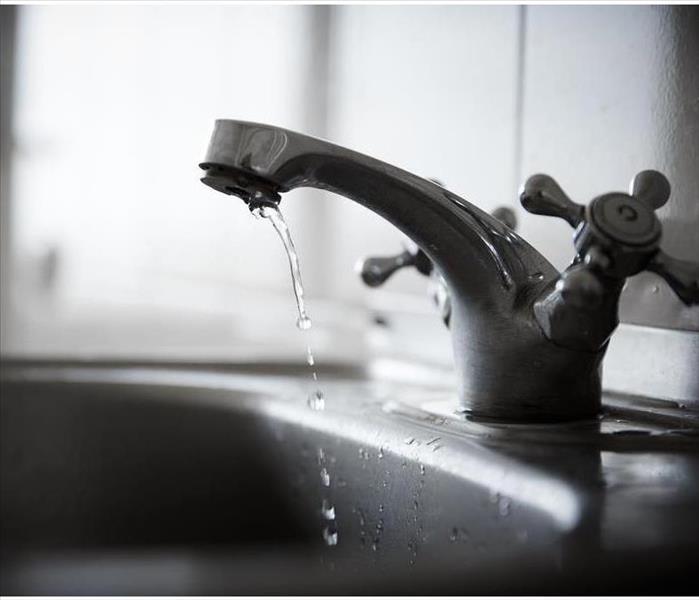 Water damage escalates to mold and microbial growth in just a few days, so don't wait to call SERVPRO (360) 703-3884.
Water damage escalates to mold and microbial growth in just a few days, so don't wait to call SERVPRO (360) 703-3884.
An overflowing bathtub or a leaking pipe may occur from time to time for some homeowners. Small mishaps like these are a daily occurrence and are usually handled without any second thoughts once the cleanup is done. Calls for water damage estimates usually are made when there are big leaks or major flooding and the need for restoration is undeniable. It is also rationale, however, to call during small floods and leaks for more than just reassurance.
Why You Should Call a Professional
1. Each category of water is different
There are three categories of water: clean, gray, and black. Water falls into each category based on its source. Each source has different implications including safety precautions and cleanup needs. This means that just because a small flood at home may have water that is “clean”, the water can be potentially harmful, needing more than just a mop and some rags to clean.
2. More than the floors may be wet
If there is slight flooding in your kitchen, bathroom, or laundry room, these areas most likely are surrounded by tile; they are also surrounded by building materials like cupboards or drywall. Drywall, unbeknownst to you, may become saturated with water and extremely heavy. The more water the drywall holds the more unstable it becomes, causing structural damage that you may not be aware of.
Electrical wires or appliances may have also taken on water, causing a high risk to homeowners as this may pose damage later on for these items.
3. You don't have the proper equipment
If a flood appears to be small and contained, there may not be a question as to the length of time the water has been apparent. Without properly vetting all surrounding areas and building materials, it is impossible to tell if a “small” flood was truly small and non-damaging. Homeowners lack the ability to make these assessments. Homeowners also lack the proper equipment to dry out areas that have experienced water damage. Even the smallest amount of moisture left, given the right environment, can pose the threat of mold damage.
When it comes to floods and accompanying water damage, leave the cleanup to the pros. Regardless of the size or area affected, water has the ability to permeate through many materials, locking moisture in where it should not exist. Call a local professional restoration company like SERVPRO of Longview/Kelso to handle all of your water cleanup needs.
Simply put, Psychrometry is The Science behind Structural Drying.
1/30/2020 (Permalink)
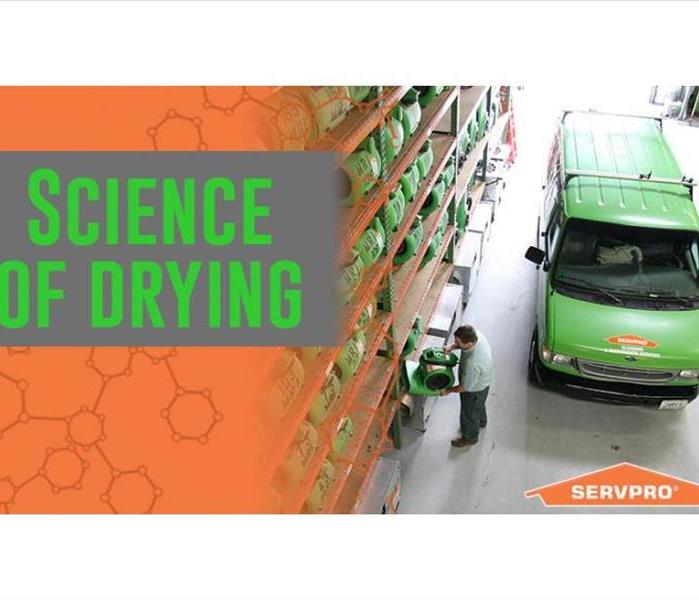 The science of drying.Psychrometry is just one of the technical aspects of restoration drying.
The science of drying.Psychrometry is just one of the technical aspects of restoration drying.
Water damage is a scary thought for any home or business owner. There are so many causes and sources of water damage ranging from sewage drain back up to burst or frozen pipes. The naked eye alone can not identify how far or deep the damage has traveled. Which is why it's essential to work with a trained professional to locate all the water damage within a property and to fully understand the science of drying the affected areas.
So What is Psychrometry?
Psychrometry is the study of the air and its properties. The properties of temperature, humidity, vapor pressure and dew point are measured to evaluate air conditions in the structure, enabling a SERVPRO Franchise Professional to create the proper atmosphere for more efficient drying.
Water can damage materials in two ways: first, by absorption through direct contact with water; and second, absorption of moisture from the air. Measuring the moisture content of the air is critical to the drying process. Similarly, during the raining seasons the moisture content of the air is high while during summers and winters its low.
Understanding these conditions and their relationship to each other will assist in determining what equipment will be needed as well as how long it will take to dry a structure and its contents. Tracking and recording these numbers daily also assures you of a successful job completion.
At SERVPRO of Longview/ Kelso we employ several tools and techniques to aid the drying process and accelerate it as well. Our most important asset is our people and the knowledge they bring to the damaged property. We are highly trained teams of IICRC Certified Water damage restoration professionals. This means when you call SERVPRO of Longview/ Kelso you are getting the highest quality of professionals to address any size disaster. We are very proud to be a leader in the emergency services and disaster restoration industry.
Winter gutter maintenance, before it's to late.
11/25/2019 (Permalink)
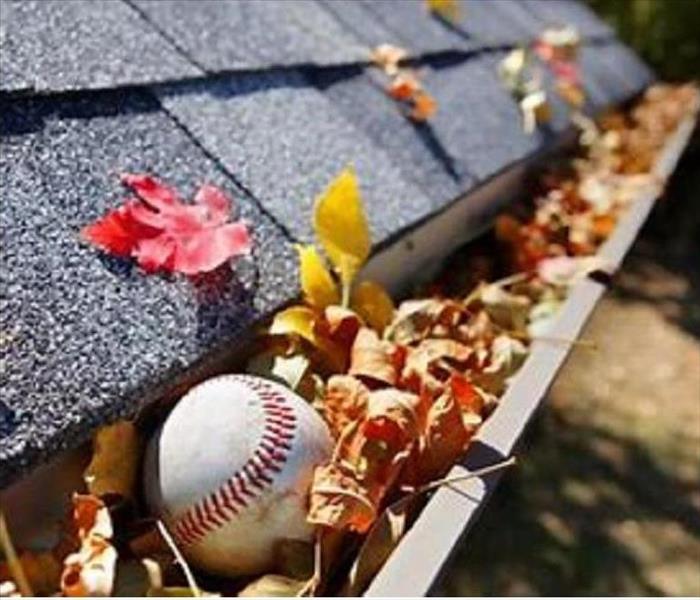 Don't strike out this winter, waiting till the damage is done.
Don't strike out this winter, waiting till the damage is done.
The colder temperatures are here and we'll soon be cleaning the frost/ice off our windshields in the morning and making sure are cars are warmed before we leave for work. Spending time outside is not ideal, especially if it's to preform yard work and maintenance.
Harsher weather is often accompanied by strong winds and drastic rain fall, which is why it's a great time to clean and check your roof and gutters. Performing these tasks is very important, to ensure your home is safe from flood and water damage. The gutters of your home and business are frequently neglected due to there visibility.
To help keep water away from your roof and foundation, gutters need to be cleared of any clogs or blockage made by leaves and debris. It's recommended to clean your gutters at least 1-4 times a year and more frequently if you have overhanging trees. Also, clean clogged gutters after big storms.
How to clean your gutters:
- Wear a shirt with long sleeves, and rubber gloves.
- Have a good extendable ladder available. Standoff stabilizers are ideal to keep the ladder from damaging the gutter.
- Use a small plastic scoop to remove gunk (A Childs sand shovel works great).
- Lay down a plastic tarp, to catch the debris.
- After you’ve cleared the muck, flush the gutters and downspouts with a garden hose (Also, a great way to spot any leaks).
Benefits of gutter cleaning:
- To prevent water damage to your home.
- Avoid nesting areas for termites, birds, and insects.
- Avert mold and bacteria.
- Prevent destruction of expensive landscaping.
- Stop ice build up and damage.
- Maintain the value and beauty of your home.
However, we can't always prevent the inevitable, which is why SERVPRO is always prepared for all of your restoration emergency's. SERVPRO of Lonview/Kelso Specializing in Water Damage cleanup and restoration (360)703-3884!
Water damage after a frozen pipe bursts
11/7/2019 (Permalink)
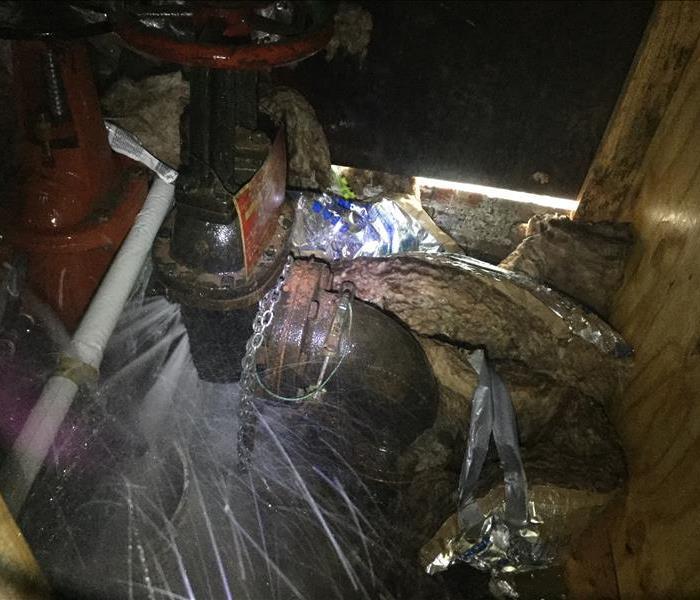 When temperatures drop to 20 F. or below this winter. It's time to actively monitor your pipes for leaks and prevent freezing.
When temperatures drop to 20 F. or below this winter. It's time to actively monitor your pipes for leaks and prevent freezing.
When temperatures drop below freezing during the winter months. Exposed pipes especially in the crawl space, basement, attic and near the exterior walls become at risk. Resulting in extensive Water Damage and costly repairs.
As the water in your pipes slowly freezes, the pressure will begin to increase. If the pressure is allowed to build, then the pipes will not be able to contain the frozen water within and can cause the pipes to break, crack and burst.
What you can do to protect pipes
- Allow faucets to drip, to minimize pressure build up and keep water moving.
- Insulate pipes.
- Open cabinet doors, to allow warmer air to circulate around plumbing.
- Maintain pipes and routinely inspect to avoid unknown water leaks.
- Always keep the thermostat on even when you are not home.
- Keep garage door closed and interior doors open.
It's important to winterize your home before winter sets in. Foam pipe insulation is a inexpensive way to protect and prevent freezing. Evan if you plan on being away for the holidays, it is recommended to follow some of these guidelines.
If you still end up with frozen pipes
Thawing a frozen water pipe quickly is important. However, it is just as considerable to thaw the frozen pipe correctly. How to safely get the water flowing and to help you avoid a pipe burst.
- Turn the main water valve off.
- Locate the frozen pipes.
- Open the faucet before you begin trying to thaw the pipe.
- Always start the thawing process closes to the faucet to avoid bursting or cracking the pipe(s).
- Use a hair dryer or other heat source to safely begin thawing.
- Once you have unthawed the pipes, it's important to check and monitor your water meter for any unseen leaks.
Even a small crack or tear can send hundreds of gallons of water each minute into your home. So taking reasonable precautions to protect your property is substantial. https://www.hunker.com/13722307/hunkermade
Your locally owned SERVPRO understands that not all disasters can be avoided. A leaky or burst pipe can occur anywhere and at anytime. Our highly trained water restoration technicians are fully prepared to respond to emergency services 24-Hours.
Immediate action is considerably large to limit any damage. We have the expertise and equipment to professionally restore your property. Give us a call SERVPRO of Longview/Kelso (360)703-3884. We'll conduct a advanced water inspection, complete extraction, and use our high-end drying equipment and techniques to restore your home. "Like it never evan happened" Locally owned and operated!
Categories of water and how they are assessed.
11/4/2019 (Permalink)
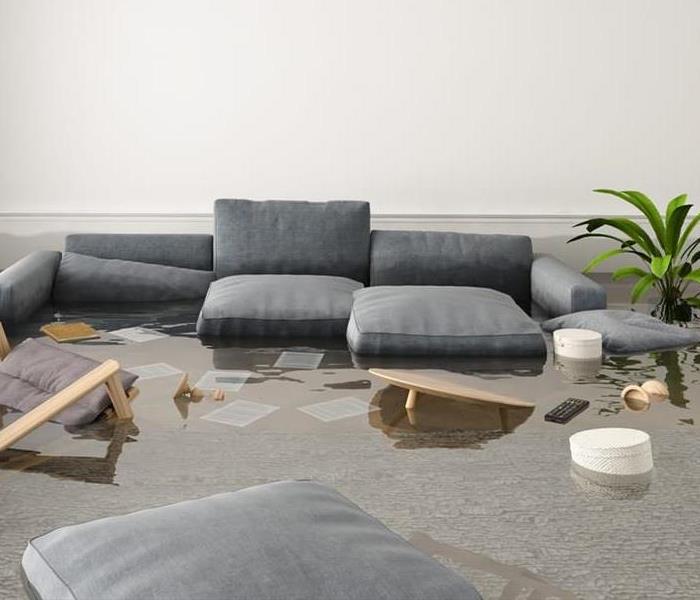 In over our heads, with no place to sit. No water loss is to big or to small, so give us a call.
In over our heads, with no place to sit. No water loss is to big or to small, so give us a call.
When we get the call for a water loss or emergency, you may be asking why we want to know "Where the water is from" and "How much has it affected". Amongst several other questions we need to ask. Here at SERVPRO from the initial phone call, to when our technicians arrive. We are assessing the damage and categorizing the type of water and classifications.
Assessing the severity of the damage is important to determine what is needed to start the restoration and water removal process. A few of the various reasons we categorize is:
- To know the level of care our technicians must take to safely work.
- Preparing what equipment or tools are needed to quickly respond to the job.
- To best advise you of other safety measures you may need to take and helpful advise to minimize damage if possible.
The 3 Categories and what they mean:
- Category 1 water/clean water
A clean source like a broken water line, appliances, sink overflow ext. The water in category 1 in other words is considered sanitary and is not yet a substantial risk.
- Category 2 water/ gray water
Water is significantly contaminated and can be harmful if consumed. Sources that may cause this type of water damage include toilets, sump pumps, and sewage.
- Category 3 water/ black water
Unsanitary water that contains bacteria, untreated sewage, harsh chemicals, and microbes. Flooding rivers and sewage backups are a couple sources that may cause this water damage but standing water and storm surges also are highly contaminated too.
We also use different classifications to help determine the extent of the water damage, you may have experienced. Which is why we ask "How much has it affected". It's important because it helps us know what drying techniques to use, the amount of equipment to set-up and how long the drying process may take.
4 Water classifications:
- Class 1 The least harmful because affected materials absorb only small amounts of the water and involves less absorption and evaporation. Commonly only a small portion of a room is affected.
- Class 2 A larger amount of water that has a fast rate of evaporation. Which means carpets and pads are affected, however water has not wicked up the walls more then 24 inches. Water damage repairs are more difficult.
- Class 3 The water in this class has the fastest rate of evaporation and the greatest amount of water. It is commonly from overhead sources or sprinkler system. It can affect ceilings, walls, insulation, carpet/pad and subflooring. Class 3 is when the entire area is affected.
- Class 4 We often use this class for specialty drying situations. It affects materials with low permeance and porosity and can have longer drying times and methods. Types of damage can affect hardwood flooring, plaster and concrete.
If water extraction isn't prompt the wet surfaces can be at risk for permanent and extended damage. If the different categories of water (category 1,2 & 3) are left untreated; for example category 1 can degrade to a category 2 or 3. We call these water changing categories. Which is why your locally owned SERVPRO responds to water damage restoration emergencies 24 hours a day.
We are prepared to help, no matter the category or class of your water emergency. We have seen it all!
SERVPRO of Longview/kelso is always ready when you need us. Trusted, local and ready to restore.
Your water damage needs are not going to wait, so why should you. Give us a call at (360)703-3884 and let our trained and certified water technicians do the rest!
Water Damage Response Tips for Homeowners
10/15/2019 (Permalink)
Water damage will strike when you least expect it in your Longview, WA home. When it does, be sure to call the bright green cleanup team, SERVPRO. Here are some helpful tips to perform before we arrive.
- Shut off the water source if possible
- Remove excess water by mopping
- Place aluminum foil under furniture legs
- Hang furs and leather goods separately at room temperature.
- Remove oriental or other colored rugs from wet carpeting
- Do not use regular vacuum to remove water
- Do not turn on ceiling fixtures if ceiling is wet, and keep away of areas where ceiling are sagging from retained water
- Do not leave books, magazines or other colored items on wet carpeting
Performing these tasks could help further damage to your home.
How A Water Restoration Technician Assists After Disaster
11/1/2017 (Permalink)
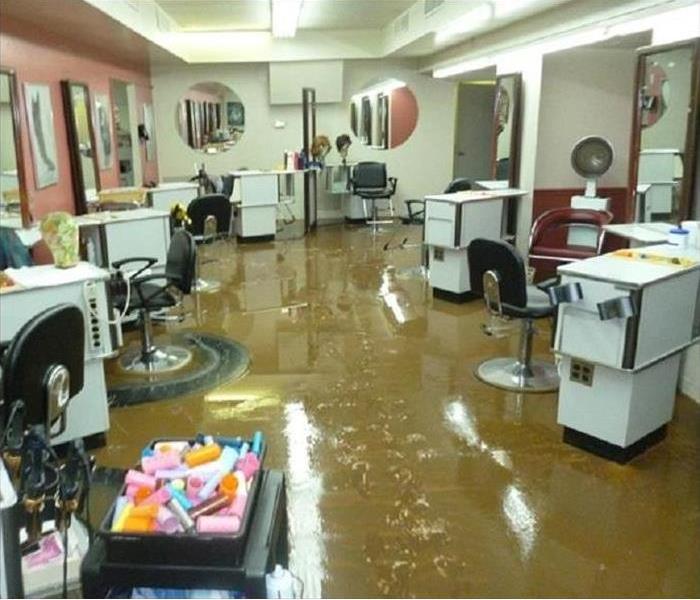 Call 360-703-3884 when you are in need of our professional service.
Call 360-703-3884 when you are in need of our professional service.
A SERVPRO water restoration technician has an extremely important job when a business or home is affected by excess moisture or fluid. Our certified professionals can quickly reverse the extensive damage that a flood, a pipe break or sewage backflow can cause, and save as many items as possible in the process. And when dealing with contaminated fluids, especially when it has pooled in the home, only certified professionals should be allowed to manage the cleanup. Attempting to perform cleanup efforts without expert assistance can lead to injury or illness, both of which can be severe.
A SERVPRO certified water restoration technician is on call around the clock, except for those times when an entire community has been affected by a major disaster. As soon as a professional is on site, they will assess the situation and determine what items need immediate rescuing. If fluid has pooled in areas around the home, then pumps will be used to remove it.
The amount of damage water can cause is amazing, and often underestimated by business owners and homeowners. Excess moisture is bad enough, but when a business or home is flooded or hit with a plumbing disaster (like a burst pipe), the situation can quickly get out of hand. There’s a reason why these incidents are among the most expensive problems a homeowner can face. Contaminated water not only creates immediate structural problems, it can leave serious biological threats behind after it has been removed.
Floods, sewage backflows, and other sources of contaminated fluid usually cause the worst damage. Dirty water is filled with all kinds of deadly substances, ranging from chemical residues to animal feces to parasites. Bacteria, viruses and fungi grow explosively in contaminated fluid, and severe health risks, like salmonella and hepatitis, are common in flood waters.
This problem is compounded by the composition of most businesses and homes, which are filled with organic materials. Drywall, wood and the matter that is trapped in carpet fibers are just a few examples, and they can give pathogens room to grow. Within 48 hours, mold may begin creeping behind the walls and releasing spores, and any organic materials that have been soaked through by contaminated fluid will usually have to be destroyed.
We, SERVPRO, will dry the business or home quickly and apply antibacterial, antiviral, and antifungal agents to all surfaces that had contact with the water. This ensures the family can return to a safe home, and not one harboring a collection of deadly pathogens.
Cowlitz County 24 Hour Emergency Water Damage Service
8/3/2016 (Permalink)
SERVPRO of Longview/Kelso is available 24 hours a day for water emergencies, large or small. When you are dealing with water damage, immediate action is crucial. A delay of just a few hours can greatly increase the severity of the water damage.
We Answer the Phone Ready to Help. Call Today – 360-703-3884
We understand that when you call us, you may be feeling confused, stressed, and vulnerable. You need an expert to guide you through this crisis. SERVPRO of Longview/Kelso has the specific water damage training and experience to help you through this tough time. We specialize in water damage restoration—in fact, it's the cornerstone of our business.
What to Expect
When you call, we will ask several questions regarding your water damage emergency. These questions will help us determine what equipment and resources to bring, including how many trained SERVPRO Professionals may be needed.
Our SERVPRO Representative will ask several questions:
Your name and contact informationYour insurance information (if applicable)The street address of the water-damaged home or businessWhen did the flooding or water damage occur?What caused the water damage (if known)?Is there electricity available (on-site)?About SERVPRO of Longview/Kelso
SERVPRO of Longview/Kelso specializes in the cleanup and restoration of residential and commercial property after a fire, smoke or water damage event. Our staff is highly trained in property damage restoration. From initial and ongoing training at SERVPRO’s corporate training facility to regular IICRC-industry certification, rest assured our staff is equipped with the knowledge to restore your property.





 24/7 Emergency Service
24/7 Emergency Service
